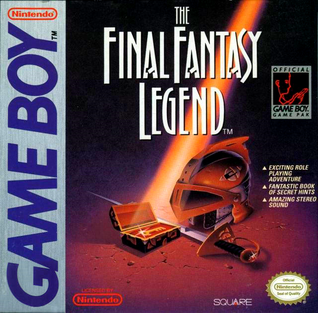
The Final Fantasy Legend, originally released in Japan as Makai Toushi Sa・Ga is a role-playing video game developed and published by Square for the Game Boy. It was originally released in Japan in December 1989 and North America in September 1990. It is the first game in the SaGa series and the first role-playing video game for the system. Square translated the game into English for worldwide release and renamed it, linking it with the Final Fantasy series to improve marketing. Sunsoft re-released it in North America during 1998; Square followed with a Japan-exclusive remake released for the WonderSwan Color and mobile phones in 2002 and 2007 respectively, it was also ported to the Nintendo Switch in 2020 and later ported to Android, iOS and Microsoft Windows in 2021.

Final Fantasy III is a role-playing video game developed and published by Square for the Family Computer. The third installment in the Final Fantasy series, it is the first numbered Final Fantasy game to feature the job-change system. The story revolves around four orphaned youths drawn to a crystal of light. The crystal grants them some of its power, and instructs them to go forth and restore balance to the world. Not knowing what to make of the crystal's pronouncements, but nonetheless recognizing the importance of its words, the four inform their adoptive families of their mission and set out to explore and bring back balance to the world.
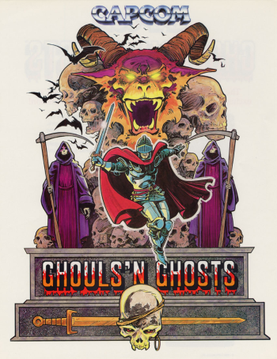
Ghouls 'n Ghosts, known as Dai Makaimura in Japan, is a side-scrolling platform game developed by Capcom, released as an arcade video game in 1988 and ported to home platforms. It is the sequel to Ghosts 'n Goblins and the second game in the Ghosts 'n Goblins series.

Ghosts 'n Goblins, known as Makaimura in Japan, is a platform video game developed by Capcom and released for arcades in 1985. It is the first game in the Ghosts 'n Goblins franchise, and has since been ported to numerous home platforms.

Maximo: Ghosts to Glory, known in Japan, Korea, Europe and Australia as Maximo, is a 3D hack and slash platform video game developed by Capcom for the PlayStation 2. The game is based on the Ghosts 'n Goblins universe and features original character designs by Japanese illustrator Susumu Matsushita. The game was followed by a sequel, Maximo vs. Army of Zin in 2003.

Maximo vs. Army of Zin is an action-adventure game developed and published by Capcom and developed by their US-based Production Studio 8 in 2003 for the PlayStation 2 video game console. It is a sequel to Maximo: Ghosts to Glory and part of the Ghosts 'n Goblins franchise. It was re-released on the PlayStation Network for the PlayStation 3 in Europe on February 15, 2012.
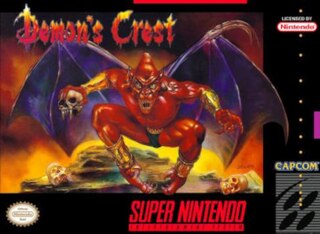
Demon's Crest, known in Japan as Demon's Blazon, is a side-scrolling platform video game developed and published by Capcom for the Super Nintendo Entertainment System. It is the third video game starring Firebrand, following Gargoyle's Quest and Gargoyle's Quest II.

Super Ghouls 'n Ghosts, known as Chou Makaimura in Japan, is a platform video game developed and published by Capcom for the Super Nintendo Entertainment System in 1991. As the third game in the Ghosts 'n Goblins series and the first not to be released for the arcade, it again depicts knight Arthur saving Princess Guinevere and the kingdom from Emperor Sardius, who has cast a spell that has revived the Ghoul Realm.
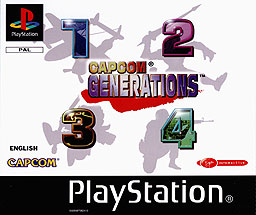
Capcom Generations is a series of five video game compilations produced by Capcom for PlayStation and Sega Saturn. Each volume contains three or four games from a particular series or game genre and were ported directly from their original arcade versions. Each disc also contains a "collection mode" featuring history, tips, artwork, character profiles, arranged music and other unlockable contents for each game. The PlayStation versions of the games also featured support for the DualShock controller.

Ultimate Ghosts 'n Goblins is a video game in Capcom's Ghosts 'n Goblins series, developed by Tose and published by Capcom. It was released for the PlayStation Portable on August 13, 2006, in Japan and August 29, 2006, in North America. Ultimate Ghosts 'n Goblins is the first game in the main series to employ 3D graphics, while maintaining much of the 2D gameplay mechanics of the earlier games. It also marks the return of the series' project head, Tokuro Fujiwara.
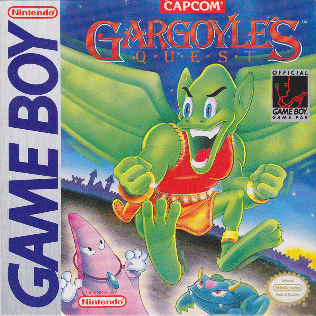
Gargoyle's Quest is an action-adventure platform game developed by Capcom for the Game Boy and released in 1990. It is a spin-off of the Ghosts 'n Goblins series, featuring the series antagonist character Firebrand as the main playable character. Gargoyle's Quest was followed by the NES prequel Gargoyle's Quest II in 1992 and the Super NES sequel Demon's Crest in 1994.

Gargoyle's Quest II: The Demon Darkness is a 1992 action-adventure game released on the NES by Capcom. It is the prequel to Gargoyle's Quest and features a similar gameplay style, which combines adventure elements with side-scrolling action in a macabre fantasy setting.

Arthur to Astaroth no Nazomakaimura: Incredible Toons is a 1996 puzzle video game for the Sega Saturn and PlayStation which was only released in Japan. Capcom licensed Dynamix's Sid & Al's Incredible Toons engine with a Ghosts 'n Goblins motif, so it is essentially a sequel to that game. The game was initially completed without the Ghosts 'n Goblins characters, which Capcom decided to add in at the last minute.
Suleputer (セルピュータ) is a record label the Japanese game development company Capcom uses for its releases. Its name derives from the full name of Capcom: "(CAP)(SULE) (COM)(PUTER)(S)".
Tokuro Fujiwara, sometimes credited as Professor F or Arthur King, is a Japanese video game designer, involved in the development of many classic Capcom video games. He directed early Capcom titles such as the run-and-gun shooter Commando (1985), the platformers Ghosts 'n Goblins (1985) and Bionic Commando (1987), and the survival horror game Sweet Home (1989). He was also a main producer for the Mega Man series and worked on the CP System arcade game Strider (1989). He also conceived of Resident Evil as a remake of his earlier game Sweet Home, and worked on the game as general producer., which introduced the Super Famicom platform in 1993. He worked as the general manager of the Capcom Console Games Division from 1988 to 1996.

Ghosts 'n Goblins, known in Japan as Makaimura, is a run-and-gun platform video game series created by Tokuro Fujiwara and developed by Capcom. The first entry in the series was Ghosts 'n Goblins, released in arcades on July 7, 1985. The series has subsequently been ported to and released on a variety of personal computers, game consoles and mobile platforms and spawned several sequels and spin-offs.

Ghosts 'n Goblins: Gold Knights and Ghosts 'n Goblins: Gold Knights II, released in Japan as Makaimura Kishi Retsuden and Makaimura Kishi Retsuden II respectively, are a pair of run and gun platform games developed and published by Capcom for iOS. Both titles were removed from the Apple App Store on May 10, 2016.
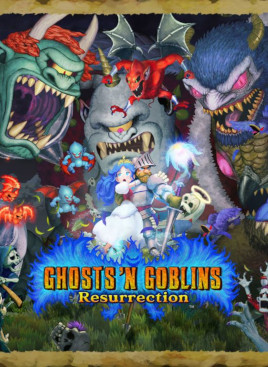
Ghosts 'n Goblins Resurrection is a platform game developed and published by Capcom for the Nintendo Switch. It is the 8th game in the Ghosts 'n Goblins series and was released on February 25, 2021 to celebrate the series' 35th anniversary. Ports for PlayStation 4, Windows, and Xbox One were released on June 1, 2021. The game received mixed reviews upon release.
















